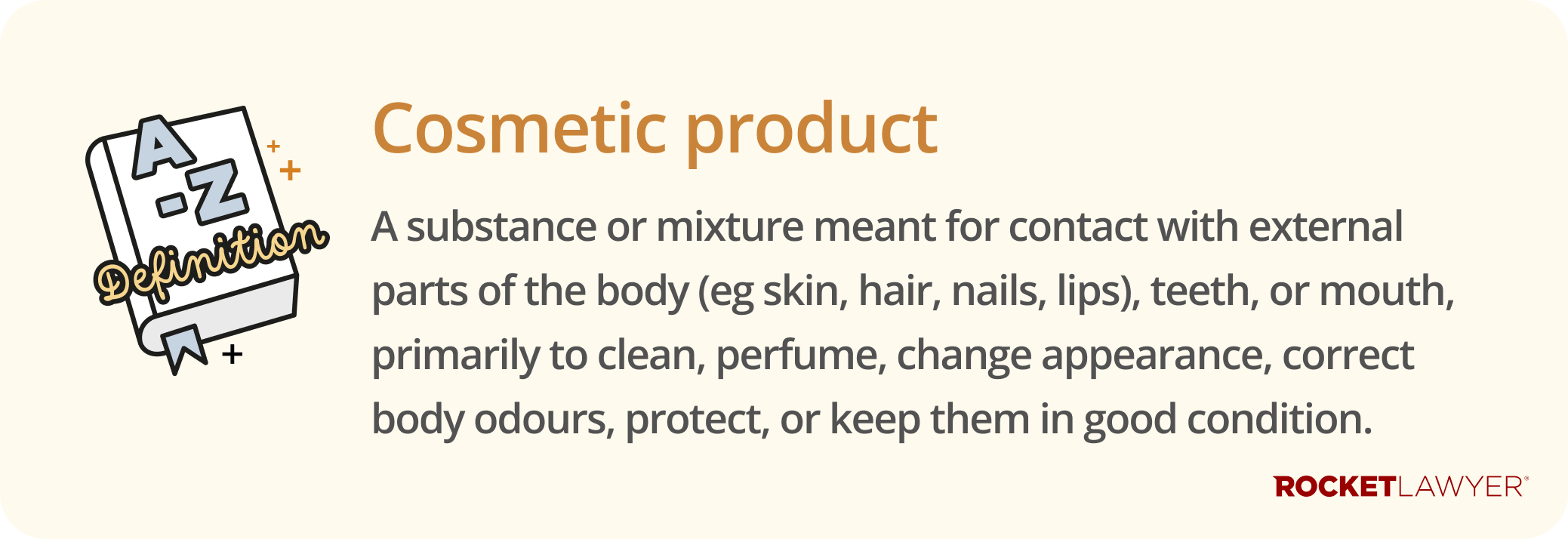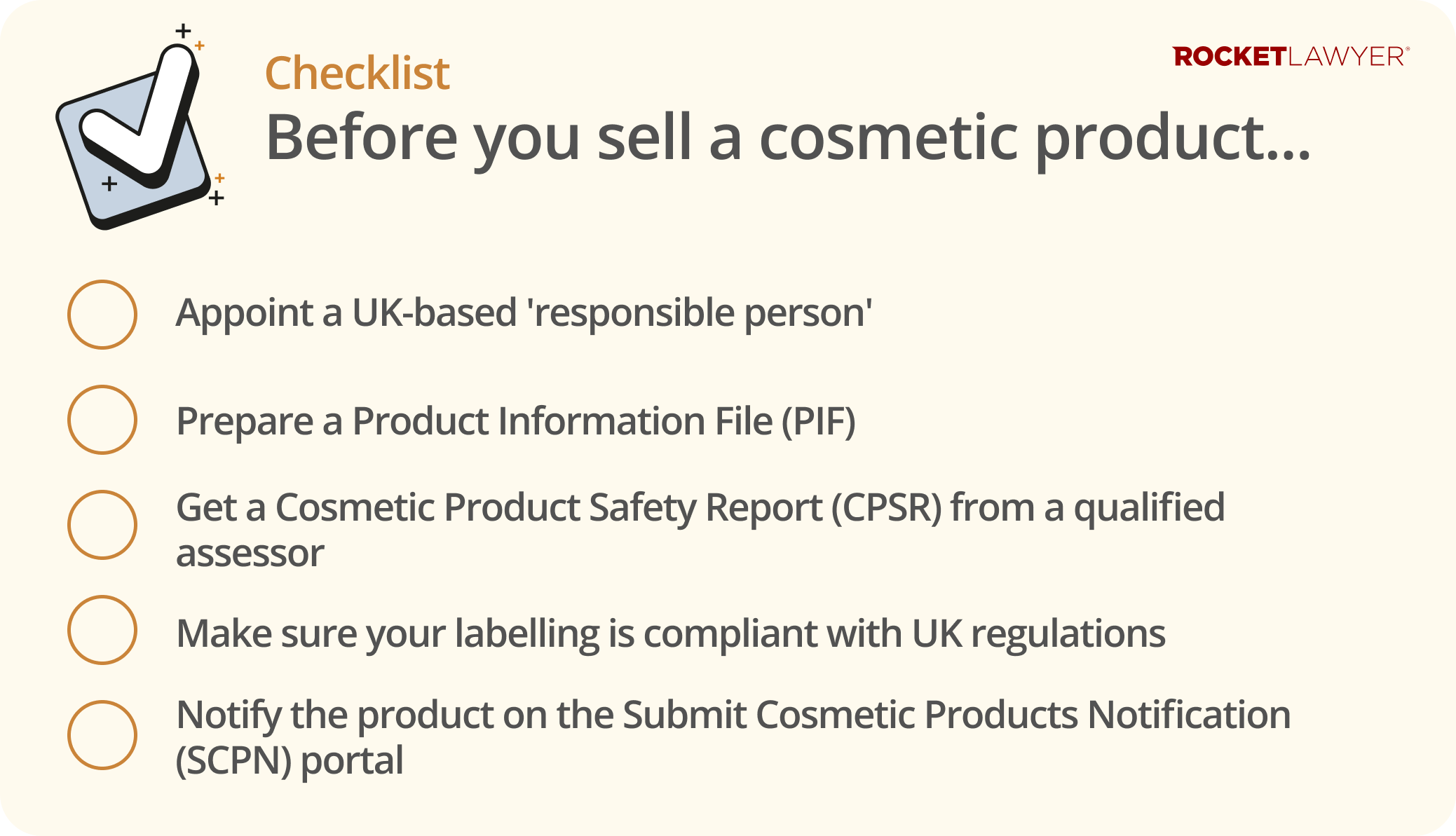What is a cosmetic product?

A cosmetic product is defined as any substance or mixture that’s intended to be placed in contact with the external parts of the human body. This includes the skin, hair, nails, lips, teeth, and inside of the mouth. The main purpose of the product must be to clean, perfume, change the appearance, correct body odours, protect, or keep these parts in good condition.
To work out if your product is a cosmetic, ask yourself three key questions:
1. What is the purpose of the product?
Is the product’s purpose fully or predominantly cosmetic? Consider if the product is intended to:
-
clean
-
change appearance
-
alter body odour and/or perfume
-
perfume
-
protect
-
maintain in good condition
If the product’s main purpose is not to perform such a function, then it is unlikely to be a cosmetic product.
2. What is the product applied to?
Consider if the product is used on the skin, hair, nails, lips, teeth, or mouth. If not, it’s unlikely to be a cosmetic.
3. What is in the product?
Does the product’s composition (ie the ingredients used to make the product) comply with the UK Cosmetic Regulations? Consider:
-
ingredients prohibited for cosmetics
-
ingredients restricted for cosmetics (certain ingredients have specified maximum amounts that can be used, eg tooth whitening products may contain a maximum of 0.1% of hydrogen peroxide)
-
preservatives, UV filters and colourants which are permitted for cosmetics (note that all preservatives, UV filters, and colourants not listed in the UK Cosmetic Regulations are not permitted)
What laws apply to cosmetics in the UK?
The laws that your cosmetic products must comply with depend on where in the UK you intend to sell them.
-
for Great Britain (England, Scotland, and Wales): products must comply with the UK Cosmetic Regulations (as set out in Schedule 34 of the Product Safety and Metrology Statutory Instrument)
-
for Northern Ireland: products must comply with the UK Cosmetic Regulations and EU Cosmetics Regulation (EC No. 1223/2009)
This means that if you sell products across the whole of the UK, you’ll need to comply with both sets of regulations.
Where cosmetics are to be sold to EU customers, sellers must comply with the EU Cosmetics Regulation.
For more information, see the Office for Product Safety and Standards (OPSS) guidance for the GB market and NI market.

Who is the 'responsible person' for a cosmetic product?
Every cosmetic product placed on the market in Great Britain must have a designated 'responsible person'. This can be an individual or a company, but they must be based in the UK.
The responsible person’s key duty is to ensure that the cosmetic product meets all legal requirements. They are the main point of contact for the authorities (eg Trading Standards) and must have access to the product's technical documentation.
The responsible person can be:
-
the manufacturer
-
the importer (if the product is made outside the UK)
-
the brand owner marketing the cosmetic product under their name or trade mark
-
a person or company based within the UK, appointed by the manufacturer or importer, to act as the responsible person
What information do I need before selling cosmetics?
Before you can place a cosmetic product on the market, you need to gather detailed information about it and have its safety formally assessed. This information is kept in two key documents: the Product Information File (PIF) and the Cosmetic Product Safety Report (CPSR).
The Product Information File (PIF)
Every cosmetic product must have its own PIF, a technical file containing all the important information about the product. A PIF must include:
-
a description of the cosmetic product
-
the Cosmetic Product Safety Report
-
details on how the cosmetic product was manufactured
-
evidence proving the effects claimed of the cosmetic product
-
any data on animal testing
The PIF is available for inspection by the relevant enforcement authority (ie Trading Standards), and the responsible person, as the party guaranteeing that the product is safe for human use, must make it accessible for inspection.
The Cosmetic Product Safety Report (CPSR)
Your cosmetic products must be safe for people to use. To prove this, a qualified safety assessor must conduct a full safety assessment and produce a CPSR before the product goes on the market.
In determining whether a cosmetic product is safe for use, the safety assessor will consider all relevant information, including:
-
the chemical makeup and toxicity of each ingredient
-
how much of each ingredient a person will be exposed to during normal use
-
the intended users (eg products for adults vs children)
-
where on the body the product will be applied
The final CPSR is a detailed report that confirms the product's safety. It includes the assessor’s conclusion, credentials, and any specific warnings that need to be included on the label.

Is animal testing on cosmetics banned in the UK?
It’s illegal to test cosmetic products or their ingredients on animals in the UK. This means that cosmetic products sold in the UK (and Europe) are not tested on animals.
All cosmetics sold in the UK must be safe, but this safety is proven through modern, non-animal assessment methods rather than animal testing. Because all cosmetics on the market must already comply with this rule, you don’t need to make a specific ‘animal friendly’ claim to meet your legal obligations.
What claims can I make about my cosmetic products?
There isn't a specific list of approved claims you can use for cosmetic products. However, any claim you make (whether in advertising, on social media, or on the product’s packaging) must be accurate, truthful, and not misleading to customers.
The responsible person must ensure that any claim made has solid evidence to support it. This evidence must be kept in the PIF. For example, if you claim your product is ‘hydrating for 8 hours’, you need to have reliable data that proves it. All claims must be fair to competitors and help customers make informed choices. You can’t imply that your product has benefits or features that it doesn’t possess.
For more information, see the Cosmetic, Toiletry and Perfumery Association (CTPA) publication on confidence in cosmetic claims.
What are the cosmetic labelling requirements?
The label on a cosmetic product provides essential information to the consumer. Generally, all cosmetic products must be labelled with the following information:
-
the name and address of the responsible person
-
the country of origin if the product is imported
-
the amount of product (by weight or volume)
-
a ‘best before’ date for products that last less than 30 months
-
a ‘period after opening’ (PAO) symbol (an open jar icon) for products that last more than 30 months, showing how long it’s safe to use after opening
-
any warnings or precuations (eg ‘avoid contact with eyes’)
-
a batch number to identify when the product was made
-
the product’s function, if it’s not obvious from its appearance (eg a ‘cream’ should be labelled as a ‘depilatory cream’ if that’s its function)
-
a full list of ingredients, using the standard 'common ingredient names'
Where cosmetic products are packaged (eg in a carton), the label should be attached to the packaging. If the products aren’t packaged, the label should be attached to the product container.
If the product is too small for all this information, the ingredients list can be provided on a leaflet, which must be indicated by a 'hand-in-book' (a hand pointing to an open book) symbol on the packaging.
How do I notify a cosmetic product for sale in Great Britain?
There is no registration or approval system for cosmetics in GB. However, before you place a product on the market, the responsible person must notify the Office for Product Safety and Standards (OPSS).
This is done through an online portal called Submit Cosmetic Products Notifications (SCPN). You’ll need to provide details about the product, its ingredients, and the responsible person. This notification allows authorities, like the National Poisons Information Service, to have information about the products on the market in case of an emergency. For more information, see the government’s guidance on submitting a cosmetic product notification.
If you have any questions about your legal obligations when selling cosmetics, do not hesitate to Ask a lawyer.



